Exam 4 - Review Microbiology 2421 (Chp. 12-13)
1/124
There's no tags or description
Looks like no tags are added yet.
Name | Mastery | Learn | Test | Matching | Spaced | Call with Kai |
|---|
No study sessions yet.
125 Terms
In the roundworms, the females have 1-2 hardened _____ on their posterior ends
Spicules
Which of the following pairs is mismatched?
Ascomycota - conidiospores
Anamorphs - lack spores
Basidiomycota - basidiospores
Microsporidia - lack mitochondria
Zygomycota - sporagiospores
Anamorphs - lack spores
Assume you have isolated a multicellular heterotrophic organism that produces coenocytic hyphae, motile zoospores, and cellulose cell walls. It is most likely a(n)
Oomycote alga
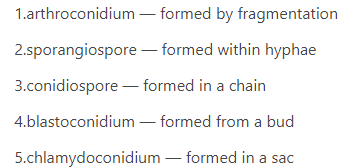
Which of the following pairs are mismatched?
2 and 5
Which of the following statements regarding fungi is FALSE?
Most fungi are pathogenic for humans
Below are paired items referring to the heartworm Dirofilaria immitis. Which of the pairs is mismatched?
Mosquito - Definitive host
Which of the following groups of algae does NOT produce compounds that are toxic to humans?
Green algae
A wolf kills a deer that is infected with ________ of Echinococcus granulosis in its liver and eats it. After consuming the deer, the wolf's intestine becomes filled with a number of ________ produced from scoleces. These eventually release eggs into the wolf's intestines, which are released in its feces.
Hydatid cysts; proglottid
Giardia and Trichomonas are unusual eukaryotes because they
Lack mitochondria
When we say that a human is a dead end host for a parasite, we mean
The infected human is highly unlikely to transmit the infection to another organism.
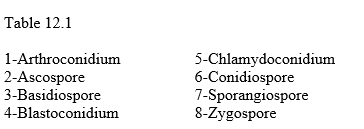
In Table 12.1, which is a thick-walled spore formed as a segment within a hypha?
5
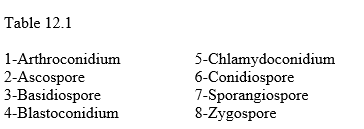
In Table 12.1, which of these spores are characteristic of Rhizopus?
7 and 8
All of the following are characteristic of algae EXCEPT which ONE of the following?
They are currently classified as plants.
Which of the following statements about the oomycote algae is FALSE?
They have chlorophyll
Which of the following statements is FALSE?
Fungal spores are highly resistant to heat and chemical agents.
What do tapeworms eat?
Intestinal contents
All of the following are characteristic of lichens EXCEPT
They are a symbiotic relationship between a fungus and a protozoan.
Which of the following pairs is mismatched?
Nematodes — complete digestive tract
Cestodes — segmented body made of proglottids
Trematodes — flukes
Nematodes — many are free-living
Cestodes — all are free-living
Cestodes - all are free living
Which of the following pairs is mismatched?
Tick — Rocky Mountain spotted fever
Tick — Lyme disease
Mosquito — malaria
Mosquito — Pneumocystis
Mosquito — encephalitis
Mosquito — Pneumocystis
A definitive host harbors which stage of a parasite?
Adult
Lysogeny can result in all of the following except
Immunity to reinfection by any phage
________ were first identified in cancer-causing viruses and can induce ______ in infected cells
Oncongenes; transformation
A persistent infection is one in which
The diesese process occurs gradually over a long period
A clear area against a confluent "lawn" of bacteria is called a
Plaque
Bacteriophages and animal viruses do NOT differ significantly in which one of the following steps?
Biosynthesis
An infectious protein is a
Prion
Most RNA viruses carry which of the following enzymes?
RNA-dependent RNA polymersase
The following steps occur during biosynthesis of a + strand RNA virus. What is the third step?
Synthesis of - strand RNA
Which of the following statements is NOT true of lysogeny?
It causes lysis of host cells
Which of the following would be the first step in biosynthesis of a virus with a - (minus) strand of RNA?
Synthesis of double-stranded RNA from an RNA template
What contributes to antigenic shift in influenza viruses?
A segmented genome
The following steps occur during multiplication of herpesviruses. Which is the third step?
Uncoating
Which of the following is most likely a product of an early gene? .
DNA polymersase .
Which of the followning is not used as a criterion to classify viruses?
Biochemical tests
Which one of the following steps does NOT occur during multiplication of a picornavirus?
Synthesis of DNA
A virus's ability to infect an animal cell depends primarily upon the
Presence of receptor sites on the cell membrane
DNA made from an RNA template will be incorporated into the virus capsid of
Hepadnaviridae
A lytic virus has infected a patient. Which of the following would best describe what is happening inside the patient?
The virus is causing the death of the infected cells in the patient.
The definition of lysogeny is
Phage DNA is incorporated into host cell DNA
An example of a latent viral infection is
Cold spores
Which of the following statements about helminths is FALSE?
All are parasites
Seventeen patients in ten hospitals had cutaneous infections caused by Rhizopus. In all seventeen patients, Elastoplast bandages were placed over sterile gauze pads to cover wounds. Fourteen of the patients had surgical wounds, two had venous line insertion sites, and one had a bite wound. Lesions present when the bandages were removed ranged from vesiculopustular eruptions to ulcerations and skin necrosis requiring debridement. Fungi are more likely than bacteria to contaminate bandages because they
Can tolerate low-moisture conditions
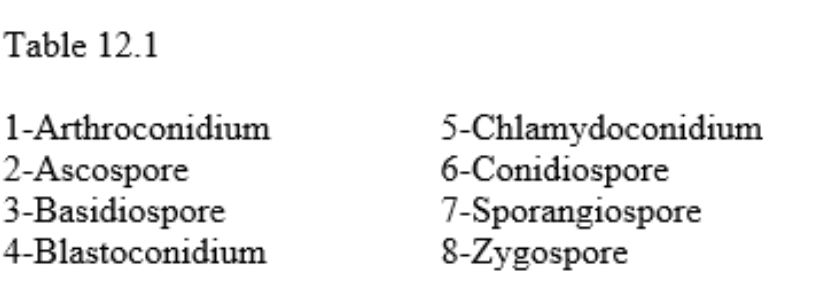
In Table 12.1, which of these spores are asexual spores?
1, 4, 5, 6, 7
Which of the following statements regarding protozoa is FALSE?
Nearly all protozoa cause disease
In mid-December, a woman with insulin-dependent diabetes who had been on prednisone fell and received an abrasion on the dorsal side of her right hand. She was placed on penicillin. By the end of January, the ulcer had not healed, and she was referred to a plastic surgeon. On January 30, a swab of the wound was cultured at 35°C on blood agar. On the same day, a smear was made for Gram staining. The Gram stain showed large (10 µm) cells. Brownish, waxy colonies grew on the blood agar. Slide cultures set up on February 1 and incubated at 25°C showed septate hyphae and single conidia. The most likely cause of the infection is a
Dimorphic fungus
Which of the following tends to be more complex in a parasitic helminth than in free-living helminths?
Reproductive system
Which of the following statements is FALSE?
Fungal spores are highly resistant to heat and chemical agents.
Which of the following pairs is mismatched?
Dinoflagellates — paralytic shellfish poisoning
Brown algae — algin
Red algae — agar
Diatoms — petroleum
Green algae — prokaryotic
Green algae — prokaryotic
Helminthic diseases are usually transmitted to humans by
Gastrointestinal route
All of the following are characteristic of the Platyhelminthes EXCEPT that they
Have highly developed digestive and nervous system
In the malaria parasite life cycle, humans are the ________ host, while mosquitoes are the ________ host as well as the vector.
Intermediate; definitive
Three weeks after a river rafting trip, three family members experienced symptoms of coughing, fever, and chest pain. During the rafting trip, the family had consumed crayfish that they caught along the river banks. An examination of the patients' sputum revealed helminth eggs, and serum samples were positive for antibodies to Paragonimus. All of the family members recovered following treatment with praziquantel. In the Paragonimus life cycle,
Humans are the definitive host and crayfish are the intermediate host
The encysted larva of the beef tapeworm is called a
Cysticercus
Which of the following arthoropods does NOT transmit disease by sucking blood from a human host?
Houseflies
Which of the following statements about algae is FALSE?
All are unicellular
All of the following characteristic of algae EXCEPT which ONE of the following?
They are currently classified as plants
The life cycle of the fish tapeworm is similar to that of the beef tapeworm. Which of the following is the most effective preventive measure?
Cooking fish before eating
Which of the following is the most effective control for malaria?
Eliminate Anopheles mosquitoes
In the microscope, you observe multinucleated amoeboid cells with sporangia that form spores. This is a(n)
Plasmodial smile mold
You observe a mass of amoeba-like cells that swarm together, form a stalk, and produce spores. This is a(n)
Cellular slime mold
Which of the following is a nucleated, unicellular organism that, if you changed the incubation temperature, would form filaments with conidiospores?
Ascomycete
Which of the following organisms is photoautotrophic protozoan?
Euglena
The cells of plasmodial slime molds can grow to several centimeters in diameter because
They distribute nutrients by cytoplasmic streaming
Ringworm is caused by a(n)
Fungus
Yeast infections are caused by
Candida albicans
You see acid-fast oocysts in a fecal sample from a patient who has diarrhea. What is the MOST likely cause?
Cryptosporidium
How do all viruses differ from bacteria?
Viruses are not composed of cells
Which of the following statements provides the most significant support for the idea that viruses are nonliving chemicals?
They cannot reproduce themselves outside a host
Which of the following statements about viral spikes is FALSE?
They are found only on nonenveloped viruses
Which of the following is NOT utilized to culture viruses?
Culture media
A viroid is a(n)
Infectious piece of RNA without a capsid
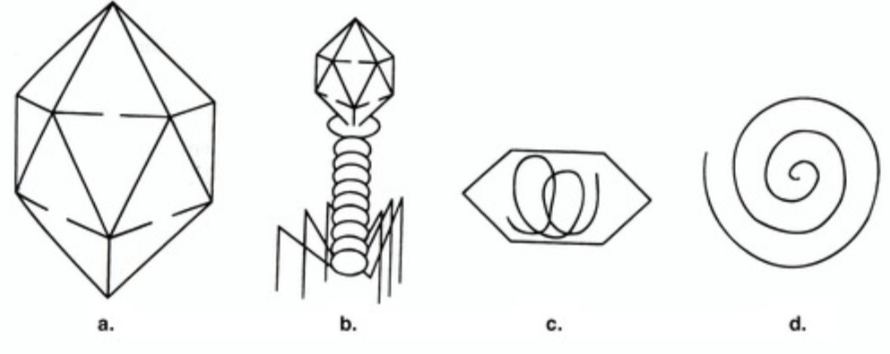
In Figure 13.1, which structure is a complex virus
B

The structures illustrated in Figure 13.1 are composed of
Capsomeres
Continuous cell lines differ from primary cell lines in that
Continuous cell lines can be maintained through an indefinite number of generations
Which of the following is necessary for replication of a prion?
PrPsc
A persistent infection is one in which
The disease process occurs gradually over a long period
Which of the following statement is FALSE?
The prophage makes the host cell immune to infections by other phages
Which of the following would be the first step in biosynthesis of a virus with a (minus) strand of RNA?
Synthesis of double-stranded RNA from a RNA template
An envelope is acquired during which of the following steps?
Release
Which of the following statements is NOT true of lysogeny?
It causes lysis of host cells
Assume you have isolated an unknown virus. This virus has a single, positive sense strand of RNA, and possesses an envelope. To which group does it most likely belong
Togavirus
The mechanism whereby an enveloped virus leaves a host cell is called
Budding
The most conclusive evidence that viruses cause cancers is provided by
Cancer following injection of cell-free filtrates
Bacteriophages derive all of the following from the host cell EXCEPT
Lysozyme
Bacteriophage replication differs from animal virus replication because only bacteriophage replication involves
Injection of naked nucleic acid into the host cell
Generally, in an infection caused by a DNA-containing virus, the host animal cell supplies all of the following EXCEPT
DNA polymerase
Which of the following places these items in the correct order for DNA-virus replication?
1. Maturation
2. DNA synthesis
3. Transcription
4. Translation
2, 3, 4, 1
A viral species is a group of viruses that
Has the same genetic information and ecological niche
Viruses that utilize reverse transcriptase belong to the virus families
Hepadnaviridae and Retroviridae
DNA made from an RNA template will be incorporated into the virus capsid of
Hepadnaviridae
Which of the following statements about viruses is FALSE?
Viruses use their own catabolic enzymes.
A lytic virus has infected a patient. Which of the following would best describe what is happening inside the patient?
The virus is causing the death of the infected cells in the patient
Some viruses, such as human herpesvirus 1, infect a cell without causing symptoms. These are called
Latent viruses
Assume a patient had chickenpox (human herpesvirus 3) as a child. Which line on the graph in Figure 13.2 would show the number of viruses present in this person as a 60-year-old with shingles (human herpesvirus 3)?
E
Assume a patient has influenza. During which time on the graph in Figure 13.2 would the patient show the symptoms of the illness
C
The following steps occur during multiplication of herpesviruses. Which is the third step?
Uncoating
The following steps occur during multiplication of retroviruses. Which is the fourth step?
Synthesis of double-stranded DNA
Oncogenic viruses
Cause tumor to develop
Which one of the following steps does NOT occur during multiplication of a picornavirus?
Synthesis of DNA
Which of the following is most likely a product of an early gene?
DNA polymerase